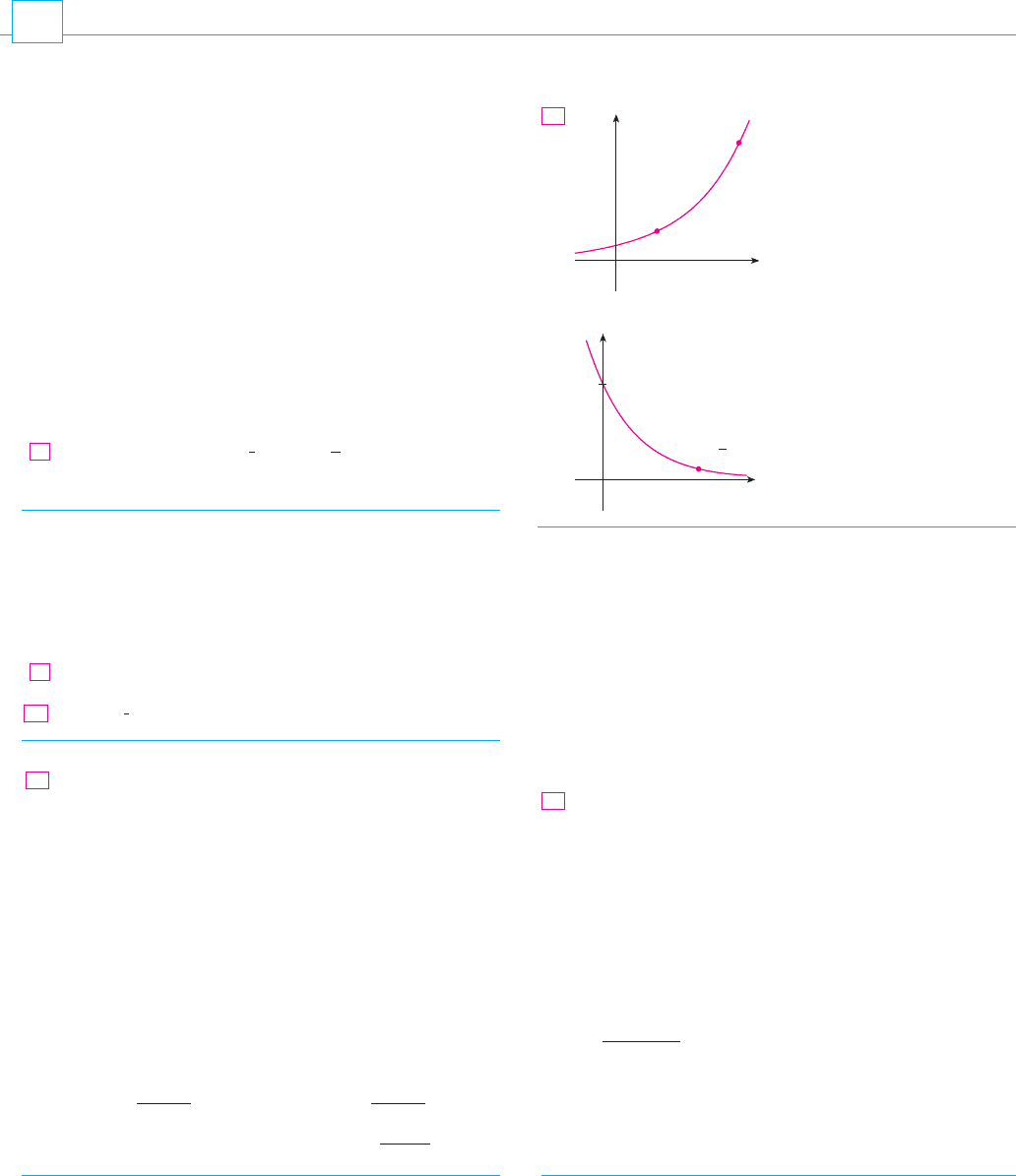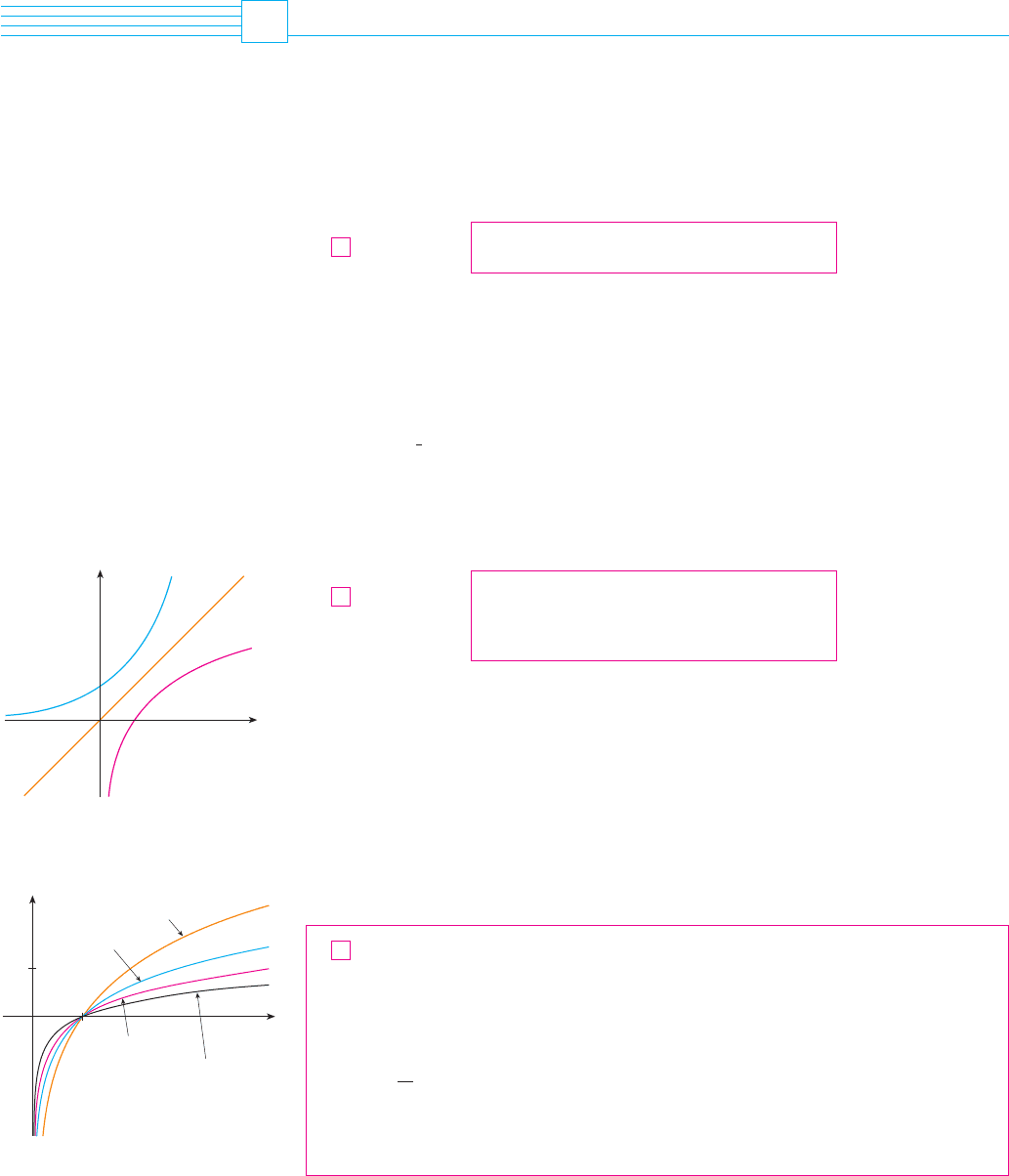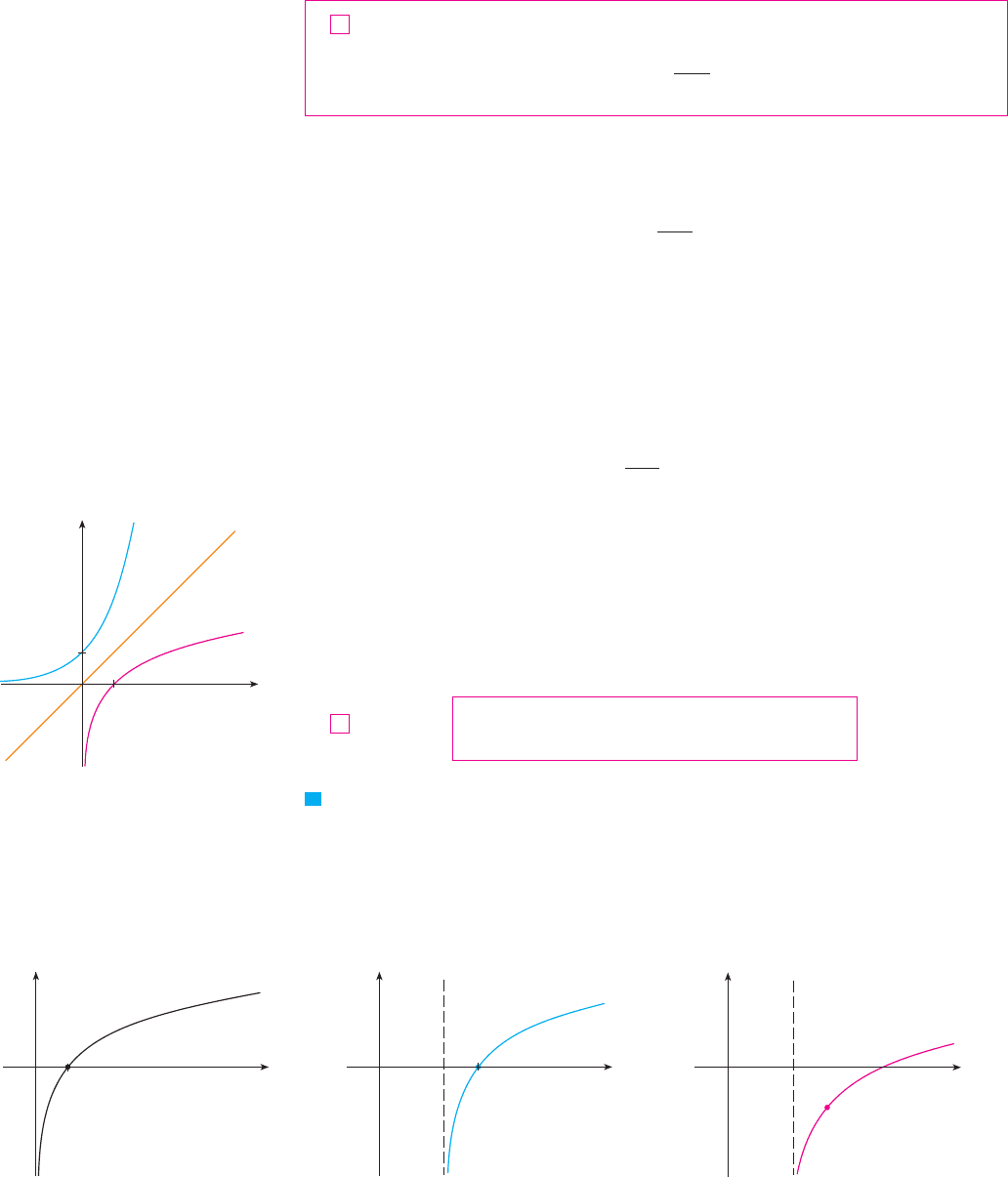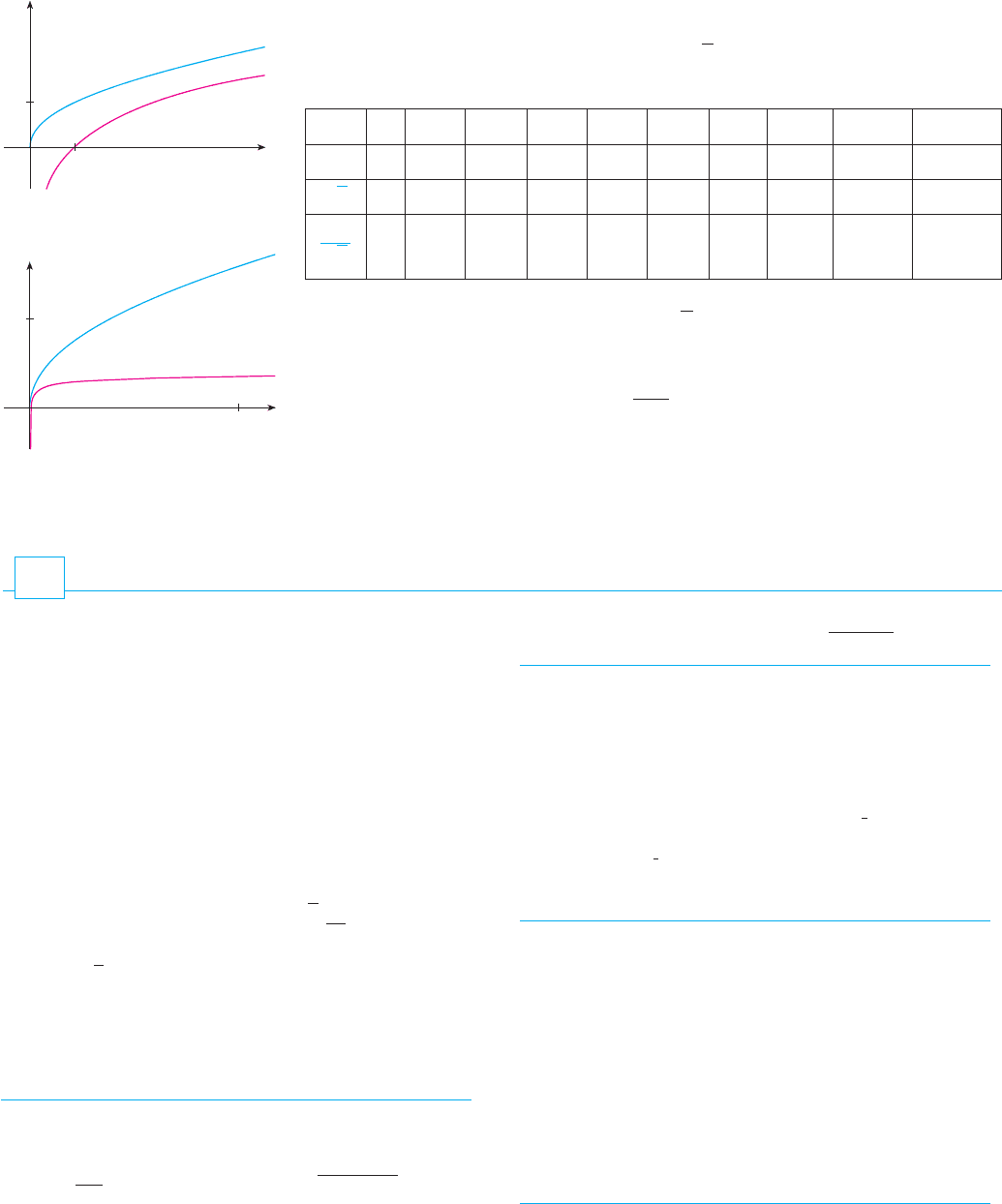Stewart J. Calculus
Подождите немного. Документ загружается.


402
|| ||
CHAPTER 7 INVERSE FUNCTIONS
17–18 Find the exponential function whose graph is
given.
18.
19. Suppose the graphs of and are drawn on
a coordinate grid where the unit of measurement is 1 inch.
Show that, at a distance 2 ft to the right of the origin, the
height of the graph of is 48 ft but the height of the graph
of is about 265 mi.
;
20. Compare the rates of growth of the functions and
by graphing both functions in several viewing rect-
angles. Find all points of intersection of the graphs correct to
one decimal place.
;
Compare the functions and by graphing
both and in several viewing rectangles. When does the
graph of finally surpass the graph of ?
;
22. Use a graph to estimate the values of such that
.
23–30 Find the limit.
23. 24.
25. 26.
27. 28.
29. 30.
lim
x
l
!
)
#2"
"
e
tan x
lim
x
l
%
!e
!2x
cos x"
lim
x
l
2
!
e
3#!2!x"
lim
x
l
2
"
e
3#!2!x"
lim
x
l
%
e
!x
2
lim
x l %
e
3x
! e
!3x
e
3x
" e
!3x
lim
x
l
!%
!1.001"
x
lim
x l %
!1.001"
x
e
x
# 1,000,000,000
x
ft
tf
t!x" ! e
x
f !x" ! x
10
21.
t!x" ! 5
x
f !x" ! x
5
t
f
t!x" ! 2
x
f !x" ! x
2
”2, ’
2
9
0
2
y
x
0
(1,6)
(3,24)
y
x
17.
f !x" ! Ca
x
1. (a) Write an equation that defines the exponential function
with base .
(b) What is the domain of this function?
(c) If , what is the range of this function?
(d) Sketch the general shape of the graph of the exponential
function for each of the following cases.
(i) (ii) (iii)
2. (a) How is the number defined?
(b) What is an approximate value for ?
(c) What is the natural exponential function?
;
3–6 Graph the given functions on a common screen. How are
these graphs related?
3. , , ,
4. , , ,
, , ,
6. , , ,
7–12 Make a rough sketch of the graph of the function. Do not
use a calculator. Just use the graphs given in Figures 3 and 12 and,
if necessary, the transformations of Section 1.3.
7. 8.
10.
12.
Starting with the graph of , write the equation of the
graph that results from
(a) shifting 2 units downward
(b) shifting 2 units to the right
(c) reflecting about the x-axis
(d) reflecting about the y-axis
(e) reflecting about the x-axis and then about the y-axis
14. Starting with the graph of , find the equation of the
graph that results from
(a) reflecting about the line
(b) reflecting about the line
15–16 Find the domain of each function.
15. (a) (b)
16. (a) (b)
t!t" !
s
1 ! 2
t
t!t" ! sin!e
!t
"
f !x" !
1
1 ! e
x
f !x" !
1
1 " e
x
x ! 2
y ! 4
y ! e
x
y ! e
x
13.
y ! 2!1 ! e
x
"y ! 1 !
1
2
e
!x
11.
y ! 1 " 2e
x
y ! !2
!x
9.
y ! 4
x! 3
y ! 4
x
! 3
y ! 0.1
x
y ! 0.3
x
y ! 0.6
x
y ! 0.9
x
y !
(
1
10
)
x
y !
(
1
3
)
x
y ! 10
x
y ! 3
x
5.
y ! 8
!x
y ! 8
x
y ! e
!x
y ! e
x
y ! 20
x
y ! 5
x
y ! e
x
y ! 2
x
e
e
0
$
a
$
1
a ! 1a # 1
a " 1
a # 0
E X E R CI SE S
7.2

rumor at time and and are positive constants. [In Sec-
tion 10.4 we will see that this is a reasonable model for .]
(a) Find .
(b) Find the rate of spread of the rumor.
;
(c) Graph for the case , with measured in
hours. Use the graph to estimate how long it will take for
80% of the population to hear the rumor.
;
60. An object is attached to the end of a vibrating spring
and its displacement from its equilibrium position is
, where is measured in seconds and is
measured in centimeters.
(a) Graph the displacement function together with the func-
tions and . How are these graphs
related? Can you explain why?
(b) Use the graph to estimate the maximum value of the dis-
placement. Does it occur when the graph touches the
graph of ?
(c) What is the velocity of the object when it first returns to
its equilibrium position?
(d) Use the graph to estimate the time after which the
displacement is no more than 2 cm from equilibrium.
61. Find the absolute maximum value of the function
.
62. Find the absolute minimum value of the function
, .
63–64 Find the absolute maximum and absolute minimum values
of on the given interval.
63. , 64. ,
65–66 Find (a) the intervals of increase or decrease, (b) the inter-
vals of concavity, and (c) the points of inflection.
65. 66.
67–68 Discuss the curve using the guidelines of Section 4.5.
68.
;
69. A drug response curve describes the level of medication in
the bloodstream after a drug is administered. A surge
function is often used to model the response
curve, reflecting an initial surge in the drug level and then a
more gradual decline. If, for a particular drug,
, and is measured in minutes, estimate the
times corresponding to the inflection points and explain their
significance. If you have a graphing device, use it to graph
the drug response curve.
tp ! 4, k ! 0.07
A ! 0.01,
S!t" ! At
p
e
!kt
y ! e
!x
sin xy ! e
!1#!x"1"
67.
f !x" !
e
x
x
2
f !x" ! !1 ! x"e
!x
)!1, 6*f !x" ! x
2
e
!x#2
)!1, 4*f !x" ! xe
!x
2
#8
f
x # 0t!x" ! e
x
#x
f !x" ! x ! e
x
y ! 8e
!t#2
y ! !8e
!t#2
y ! 8e
!t#2
yty ! 8e
!t#2
sin 4t
tk ! 0.5a ! 10p
lim
t l %
p!t"
p!t"
kat
31– 46 Differentiate the function.
31. 32.
34.
35. 36.
38.
39. 40.
41. 42.
43. 44.
45. 46.
47– 48 Find an equation of the tangent line to the curve at the
given point.
47. ,
Find if .
50. Find an equation of the tangent line to the curve
at the point .
51. Show that the function satisfies the differen-
tial equation .
52. Show that the function satisfies the differ-
ential equation .
53. For what values of does the function satisfy the
equation ?
54. Find the values of for which satisfies the equation
.
If , find a formula for .
56. Find the thousandth derivative of .
57. (a) Use the Intermediate Value Theorem to show that there is
a root of the equation .
(b) Use Newton’s method to find the root of the equation in
part (a) correct to six decimal places.
;
58. Use a graph to find an initial approximation (to one decimal
place) to the root of the equation .
Then use Newton’s method to find the root correct to eight
decimal places.
59. Under certain circumstances a rumor spreads according to the
equation
where is the proportion of the population that knows the p!t"
p!t" !
1
1 " ae
!kt
4e
!x
2
sin x ! x
2
! x " 1
e
x
" x ! 0
f !x" ! xe
!x
f
!n"
!x"f !x" ! e
2x
55.
y " y& ! y'
y ! e
*
x
*
y' " 6y& " 8y ! 0
y ! e
rx
r
y' " 2y& " y ! 0
y ! Ae
!x
" Bxe
!x
2y' ! y& ! y ! 0
y ! e
x
" e
! x / 2
!0, 1"xe
y
" ye
x
! 1
e
x
2
y
! x " yy&
49.
!1, e"y !
e
x
x
48.
y ! e
2x
cos
)
x, !0, 1"
f !t" ! sin
2
!e
sin
2
t
"y ! cos
+
1 ! e
2x
1 " e
2x
,
y !
s
1 " xe
!2x
y !
ae
x
" b
ce
x
" d
y !
e
u
! e
!u
e
u
" e
!u
y ! e
e
x
y ! e
k tan
s
x
y !
s
1 " 2e
3x
f !t" ! sin!e
t
" " e
sin t
F!t" ! e
t sin 2t
37.
t!x" !
s
x
e
x
f !u" ! e
1#u
y ! e
u
!cos u " cu"y ! e
ax
3
33.
y !
e
x
1 " x
f !x" ! !x
3
" 2x"e
x
SECTION 7.2 EXPONENTIAL FUNCTIONS AND THEIR DERIVATIVES
|| ||
403

87. The error function
is used in probability, statistics, and engineering.
(a) Show that .
(b) Show that the function satisfies the differ-
ential equation .
88. A bacteria population starts with 400 bacteria and grows at a
rate of bacteria per hour. How many
bacteria will there be after three hours?
89. If , find .
90. Evaluate .
;
91. If you graph the function
you’ll see that appears to be an odd function. Prove it.
;
92. Graph several members of the family of functions
where . How does the graph change when changes?
How does it change when changes?
93. (a) Show that if .
[Hint: Show that is increasing
for .]
(b) Deduce that .
94. (a) Use the inequality of Exercise 93(a) to show that, for
(b) Use part (a) to improve the estimate of given in
Exercise 93(b).
95. (a) Use mathematical induction to prove that for and
any positive integer ,
(b) Use part (a) to show that .
(c) Use part (a) to show that
for any positive integer .k
lim
x l !
e
x
x
k
! !
e " 2.7
e
x
# 1 $ x $
x
2
2!
$ % % % $
x
n
n!
n
x # 0
x
1
0
e
x
2
dx
e
x
# 1 $ x $
1
2
x
2
x # 0,
4
3
& x
1
0
e
x
2
dx & e
x " 0
f !x" ! e
x
' !1 $ x"
x # 0e
x
# 1 $ x
a
ba " 0
f !x" !
1
1 $ ae
bx
f
f !x" !
1 ' e
1#x
1 $ e
1#x
lim
x l
(
e
sin x
' 1
x '
(
! f
'1
")!4"f !x" ! 3 $ x $ e
x
r!t" ! !450.268"e
1.12567t
y) ! 2xy $ 2#
s
(
y ! e
x
2
erf!x"
x
b
a
e
't
2
dt !
1
2
s
(
$erf!b" ' erf!a"%
erf!x" !
2
s
(
y
x
0
e
't
2
dt
;
70 – 71 Draw a graph of that shows all the important aspects of
the curve. Estimate the local maximum and minimum values and
then use calculus to find these values exactly. Use a graph of
to estimate the inflection points.
70. 71.
72. The family of bell-shaped curves
occurs in probability and statistics, where it is called the nor-
mal density function. The constant is called the mean and
the positive constant is called the standard deviation. For
simplicity, let’s scale the function so as to remove the factor
and let’s analyze the special case where .
So we study the function
(a) Find the asymptote, maximum value, and inflection points
of .
(b) What role does play in the shape of the curve?
;
(c) Illustrate by graphing four members of this family on the
same screen.
73– 82 Evaluate the integral.
73. 74.
76.
77. 78.
79. 80.
82.
83. Find, correct to three decimal places, the area of the region
bounded by the curves , , and .
84. Find if , , and .
85. Find the volume of the solid obtained by rotating about the
-axis the region bounded by the curves , , ,
and .
Find the volume of the solid obtained by rotating about the
-axis the region bounded by the curves , ,
, and .x ! 1x ! 0
y ! 0y ! e
'x
2
y
86.
x ! 1
x ! 0y ! 0y ! e
x
x
f )!0" ! 2f !0" ! 1f *!x" ! 3e
x
$ 5 sin xf !x"
x ! 1y ! e
3x
y ! e
x
y
e
x
sin!e
x
" dx
y
e
s
x
s
x
dx
81.
y
e
1#x
x
2
dx
y
sin x e
cos x
dx
y
e
x
!4 $ e
x
"
5
dx
y
!e
x
$ e
'x
"
2
dx
y
!1 $ e
x
"
2
e
x
dx
y
e
x
s
1 $ e
x
dx
75.
y
1
0
xe
'x
2
dx
y
5
0
e
'3x
dx
+
f
f !x" ! e
'x
2
#!2
+
2
"
,
! 01#
(
+
s
2
(
)
+
,
y !
1
+
s
2
(
e
'!x'
,
"
2
#!2
+
2
"
f !x" ! e
x
3
'x
f !x" ! e
cos x
f *
f
404
|| ||
CHAPTER 7 INVERSE FUNCTIONS

LOG ARIT HMI C FUN CTI O NS
If and , the exponential function is either increasing or decreasing
and so it is one-to-one. It therefore has an inverse function , which is called the logarith-
mic function with base a and is denoted by . If we use the formulation of an inverse
function given by (7.1.3),
then we have
Thus, if , then is the exponent to which the base must be raised to give .
EXAMPLE 1 Evaluate (a) , (b) , and (c) .
SOLUTION
(a) because
(b) because
(c) because M
The cancellation equations (7.1.4), when applied to and ,
become
The logarithmic function has domain and range and is continuous since it
is the inverse of a continuous function, namely, the exponential function. Its graph is the
reflection of the graph of about the line .
Figure 1 shows the case where . (The most important logarithmic functions have
base .) The fact that is a very rapidly increasing function for is
reflected in the fact that is a very slowly increasing function for .
Figure 2 shows the graphs of with various values of the base . Since
, the graphs of all logarithmic functions pass through the point .
The following theorem summarizes the properties of logarithmic functions.
THEOREM If , the function is a one-to-one, continuous,
increasing function with domain and range . If , and r is any real
number, then
1.
2.
3. log
a
!x
r
" ! r log
a
x
log
a
&
x
y
'
! log
a
x ' log
a
y
log
a
!xy" ! log
a
x $ log
a
y
y " 0x!!0, !"
f !x" ! log
a
xa " 1
3
!1, 0"log
a
1 ! 0
ay ! log
a
x
x " 1y ! log
a
x
x " 0y ! a
x
a " 1
a " 1
y ! xy ! a
x
!!0, !"log
a
a
log
a
x
! x for every x " 0
log
a
!a
x
" ! x for every x ! !
2
f
'1
!x" ! log
a
xf !x" ! a
x
10
'3
! 0.001log
10
0.001 ! '3
25
1#2
! 5log
25
5 !
1
2
3
4
! 81log
3
81 ! 4
log
10
0.001log
25
5log
3
81
xalog
a
xx " 0
a
y
! x&?log
a
x ! y
1
f !y" ! x&?f
'1
!x" ! y
log
a
f
'1
f !x" ! a
x
a " 1a " 0
7.3
SECTION 7.3 LOGARITHMIC FUNCTIONS
|| ||
405
0
y=x
y=a®,a>1
y=log
a
x, a>1
F I G U R E 1
y
x
F I G U R E 2
0
y
1
x
1
y=log£x
y=log™x
y=log∞x
y=log¡¸x

Properties 1, 2, and 3 follow from the corresponding properties of exponential functions
given in Section 7.2.
EXAMPLE 2 Use the properties of logarithms in Theorem 3 to evaluate the following.
(a) (b)
SOLUTION
(a) Using Property 1 in Theorem 3, we have
since .
(b) Using Property 2 we have
since .
M
The limits of exponential functions given in Section 7.2 are reflected in the following
limits of logarithmic functions. (Compare with Figure 1.)
If , then
In particular, the -axis is a vertical asymptote of the curve .
EXAMPLE 3 Find .
SOLUTION As , we know that and the values of are positive.
So by (4) with , we have
M
NATURAL LOGA R I T H M S
Of all possible bases for logarithms, we will see in the next section that the most con-
venient choice of a base is the number , which was defined in Section 7.2. The logarithm
with base is called the natural logarithm and has a special notation:
If we put and replace with “ln” in (1) and (2), then the defining properties
of the natural logarithm function become
e
ln x
! x x " 0
ln!e
x
" ! x x ! !
6
e
y
! x&?ln x ! y
5
log
e
a ! e
log
e
x ! ln x
e
e
a
lim
x
l
0
log
10
!tan
2
x" ! lim
tl
0
$
log
10
t ! '!
a ! 10 " 1
tt ! tan
2
x l tan
2
0 ! 0x l 0
lim
x l 0
log
10
!tan
2
x"
y ! log
a
xy
lim
x
l
!
log
a
x ! ! and lim
x
l
0
$
log
a
x ! '!
a " 1
4
2
4
! 16
log
2
80 ' log
2
5 ! log
2
(
80
5
)
! log
2
16 ! 4
4
3
! 64
log
4
2 $ log
4
32 ! log
4
!2 " 32" ! log
4
64 ! 3
log
2
80 ' log
2
5log
4
2 $ log
4
32
406
|| ||
CHAPTER 7 INVERSE FUNCTIONS
N NOTATION FOR LOGARITHMS
Most textbooks in calculus and the sciences, as
well as calculators, use the notation for the
natural logarithm and for the “common
logarithm,” . In the more advanced mathe-
matical and scientific literature and in computer
languages, however, the notation usually
denotes the natural logarithm.
log x
log
10
x
log x
ln x

In particular, if we set , we get
EXAMPLE 4 Find if .
SOLUTION 1 From (5) we see that
Therefore .
(If you have trouble working with the “ln” notation, just replace it by . Then the
equation becomes ; so, by the definition of logarithm, .)
SOLUTION 2 Start with the equation
and apply the exponential function to both sides of the equation:
But the second cancellation equation in (6) says that . Therefore . M
EXAMPLE 5 Solve the equation .
SOLUTION We take natural logarithms of both sides of the equation and use (6):
Since the natural logarithm is found on scientific calculators, we can approximate the
solution: to four decimal places, .
M
EXAMPLE 6 Express as a single logarithm.
SOLUTION Using Properties 3 and 1 of logarithms, we have
M
The following formula shows that logarithms with any base can be expressed in terms
of the natural logarithm.
! ln
(
a
s
b
)
! ln a $ ln
s
b
ln a $
1
2
ln b ! ln a $ ln b
1#2
ln a $
1
2
ln b
V
x ( 0.8991
x !
1
3
!5 ' ln 10"
3x ! 5 ' ln 10
5 ' 3x ! ln 10
ln!e
5'3x
" ! ln 10
e
5'3x
! 10
V
x ! e
5
e
ln x
! x
e
ln x
! e
5
ln x ! 5
e
5
! xlog
e
x ! 5
log
e
x ! e
5
e
5
! xmeansln x ! 5
ln x ! 5x
ln e ! 1
x ! 1
SECTION 7.3 LOGARITHMIC FUNCTIONS
|| ||
407

CHANGE OF BASE FORMULA For any positive number , we have
PROOF Let . Then, from (1), we have . Taking natural logarithms of both
sides of this equation, we get . Therefore
M
Scientific calculators have a key for natural logarithms, so Formula 7 enables us to use
a calculator to compute a logarithm with any base (as shown in the following example).
Similarly, Formula 7 allows us to graph any logarithmic function on a graphing calculator
or computer (see Exercises 20–22).
EXAMPLE 7 Evaluate correct to six decimal places.
SOLUTION Formula 7 gives
M
The graphs of the exponential function and its inverse function, the natural log-
arithm function, are shown in Figure 3. Because the curve crosses the y-axis with
a slope of 1, it follows that the reflected curve crosses the x-axis with a slope of 1.
In common with all other logarithmic functions with base greater than 1, the natural
logarithm is a continuous, increasing function defined on and the y-axis is a vertical
asymptote.
If we put in (4), then we have the following limits:
EXAMPLE 8 Sketch the graph of the function .
SOLUTION We start with the graph of as given in Figure 3. Using the transforma-
tions of Section 1.3, we shift it 2 units to the right to get the graph of and
then we shift it 1 unit downward to get the graph of . (See Figure 4.)
Notice that the line is a vertical asymptote since
M
F I G U R E 4
0
y
2
x
(3,0)
x=2
y=ln(x-2)
0
y
x
y=lnx
(1,0)
0
y
2
x
x=2
(3,_1)
y=ln(x-2)-1
lim
x
l
2
$
$ln!x ' 2" ' 1% ! '!
x ! 2
y ! ln!x ' 2" ' 1
y ! ln!x ' 2"
y ! ln x
y ! ln!x ' 2" ' 1
V
lim
x
l
!
ln x ! ! lim
x
l
0
$
ln x ! '!
8
a ! e
!0, !"
y ! ln x
y ! e
x
y ! e
x
log
8
5 !
ln 5
ln 8
( 0.773976
log
8
5
y !
ln x
ln a
y ln a ! ln x
a
y
! xy ! log
a
x
log
a
x !
ln x
ln a
!a " 1"a
7
408
|| ||
CHAPTER 7 INVERSE FUNCTIONS
y
1
0
x
1
y=x
y=´
y=lnx
F I G U R E 3

We have seen that as . But this happens very slowly. In fact, grows
more slowly than any positive power of x. To illustrate this fact, we compare approximate
values of the functions and in the following table and we graph
them in Figures 5 and 6.
You can see that initially the graphs of and grow at comparable rates,
but eventually the root function far surpasses the logarithm. In fact, we will be able to show
in Section 7.8 that
for any positive power . So for large , the values of are very small compared with
. (See Exercise 70.)x
p
ln xxp
lim
x l !
ln x
x
p
! 0
y ! ln xy !
s
x
y ! x
1#2
!
s
x
y ! ln x
ln xx l !ln x l !
SECTION 7.3 LOGARITHMIC FUNCTIONS
|| ||
409
x 1 2 5 10 50 100 500 1000 10,000 100,000
0 0.69 1.61 2.30 3.91 4.6 6.2 6.9 9.2 11.5
1 1.41 2.24 3.16 7.07 10.0 22.4 31.6 100 316
0 0.49 0.72 0.73 0.55 0.46 0.28 0.22 0.09 0.04
ln x
s
x
s
x
ln x
x
0
y
1
1
y=œ
„
x
y=lnx
F I G U R E 5
x
0
y
1000
20
y=œ
„
x
y=lnx
F I G U R E 6
11. 12.
13–18 Express the quantity as a single logarithm.
13.
14.
15. 16.
17.
18.
19. Use Formula 7 to evaluate each logarithm correct to six deci-
mal places.
(a) (b) (c)
;
20 – 22 Use Formula 7 to graph the given functions on a com-
mon screen. How are these graphs related?
20. , , ,
21. , , ,
22. , , , y ! 10
x
y ! e
x
y ! log
10
xy ! ln x
y ! log
50
xy ! log
10
xy ! ln xy ! log
1.5
x
y ! log
8
xy ! log
6
xy ! log
4
xy ! log
2
x
log
2
(
log
6
13.54log
12
e
ln!a $ b" $ ln!a ' b" ' 2 ln c
ln!1 $ x
2
" $
1
2
ln x ' ln sin x
ln 3 $
1
3
ln 8ln 5 $ 5 ln 3
ln!x $ y" $ ln!x ' y" ' 2 ln z
log
10
a ' log
10
b $ log
10
c
ln
3x
2
!x $ 1"
5
ln!uv"
10
1. (a) How is the logarithmic function defined?
(b) What is the domain of this function?
(c) What is the range of this function?
(d) Sketch the general shape of the graph of the function
if .
2. (a) What is the natural logarithm?
(b) What is the common logarithm?
(c) Sketch the graphs of the natural logarithm function and
the natural exponential function with a common set of
axes.
3– 8 Find the exact value of each expression.
3. (a) (b)
4. (a) (b)
5. (a) (b)
6. (a) (b)
7. (a)
(b)
8. (a) (b)
9–12 Use the properties of logarithms to expand the quantity.
9. 10. ln
s
a!b
2
$ c
2
"
log
2
&
x
3
y
z
2
'
ln
(
ln e
e
10
)
e
'2 ln 5
log
3
100 ' log
3
18 ' log
3
50
log
2
6 ' log
2
15 $ log
2
20
log
8
320 ' log
8
5log
10
0.1
e
ln 15
log
5
1
25
log
10
s
10
ln!1#e"
log
3
1
27
log
5
125
a " 1y ! log
a
x
y ! log
a
x
E X E R C I S E S
7.3

loudness, in decibels (dB), of a sound with intensity is then
defined to be . Amplified rock music is
measured at 120 dB, whereas the noise from a motor-driven
lawn mower is measured at 106 dB. Find the ratio of the inten-
sity of the rock music to that of the mower.
43.
If a bacteria population starts with 100 bacteria and doubles
every three hours, then the number of bacteria after hours
is .
(a) Find the inverse of this function and explain its meaning.
(b) When will the population reach 50,000?
44.
When a camera flash goes off, the batteries immediately begin
to recharge the flash’s capacitor, which stores electric charge
given by
(The maximum charge capacity is and is measured in
seconds.)
(a) Find the inverse of this function and explain its meaning.
(b) How long does it take to recharge the capacitor to 90% of
capacity if ?
45–50
Find the limit.
45. 46.
48.
49.
50.
51–52
Find the domain of the function.
51. 52.
53–54
Find (a) the domain of and (b) and its domain.
53. 54.
55–60
Find the inverse function.
55. 56.
58.
,
59. 60.
61.
On what interval is the function increasing?
62. On what interval is the curve concave
downward?
63. On what intervals is the curve concave
upward?
y ! !x
2
' 2"e
'x
y ! 2e
x
' e
'3x
f !x" ! e
3x
' e
x
y !
e
x
1 $ 2e
x
y ! log
10
&
1 $
1
x
'
x # 1y ! !ln x"
2
f !x" ! e
x
3
57.
y ! 2
10
x
y ! ln!x $ 3"
f!x" ! ln!2 $ ln x"f!x" !
s
3 ' e
2x
f
'1
f
f !x" ! ln x $ ln!2 ' x"f !x" ! log
10
!x
2
' 9"
lim
x l !
$ln!2 $ x" ' ln!1 $ x"%
lim
x
l
!
$ln!1 $ x
2
" ' ln!1 $ x"%
lim
x
l
0
$
ln!sin x"lim
x
l
0
ln!cos x"
47.
lim
x
l
2
'
log
5
!8x ' x
4
"lim
x
l
3
$
ln!x
2
' 9"
a ! 2
tQ
0
Q!t" ! Q
0
!1 ' e
't#a
"
n ! f !t" ! 100 % 2
t#3
t
L ! 10 log
10
!I#I
0
"
I
23–24
Make a rough sketch of the graph of each function. Do not
use a calculator. Just use the graphs given in Figures 2 and 3 and,
if necessary, the transformations of Section 1.3.
(a) (b)
24.
(a) (b)
25–34
Solve each equation for .
25.
(a) (b)
26.
(a) (b)
(a) (b)
28.
(a) (b)
29. 30.
31. 32.
33.
35 –36
Find the solution of the equation correct to four decimal
places.
35.
(a) (b)
36.
(a) (b)
37–38
Solve each inequality for .
37.
(a) (b)
38.
(a) (b)
Suppose that the graph of is drawn on a coordinate
grid where the unit of measurement is an inch. How many
miles to the right of the origin do we have to move before the
height of the curve reaches ft?
40.
The velocity of a particle that moves in a straight line under the
influence of viscous forces is , where and are
positive constants.
(a) Show that the acceleration is proportional to the velocity.
(b) Explain the significance of the number .
(c) At what time is the velocity equal to half the initial velocity?
41.
The geologist C. F. Richter defined the magnitude of an
earthquake to be , where is the intensity of the
quake (measured by the amplitude of a seismograph 100 km
from the epicenter) and is the intensity of a “standard”
earthquake (where the amplitude is only 1 micron cm).
The 1989 Loma Prieta earthquake that shook San Francisco
had a magnitude of 7.1 on the Richter scale. The 1906 San
Francisco earthquake was 16 times as intense. What was its
magnitude on the Richter scale?
42.
A sound so faint that it can just be heard has intensity
watt#m at a frequency of 1000 hertz (Hz). The
2
I
0
! 10
'12
! 10
'4
S
Ilog
10
!I#S "
c
kc
v
!t" ! ce
'kt
3
y ! log
2
x
39.
e
2'3x
" 4
2
-
ln x
-
9
ln x " '1
e
x
-
10
x
3
1#!x'4"
! 7ln
(
1 $
s
x
)
! 2
ln!e
x
' 2" ! 3e
2$5x
! 100
ln!2x $ 1" ! 2 ' ln x
34.
e
2x
' e
x
' 6 ! 0
e
e
x
! 10ln!ln x" ! 1
10!1 $ e
'x
"
'1
! 33xe
x
$ x
2
e
x
! 0
log
2
!mx" ! c
e
3x$1
! k
ln x $ ln!x ' 1" ! 12
x'5
! 3
27.
ln!5 ' 2x" ! '3e
2x$ 3
' 7 ! 0
e
'x
! 52 ln x ! 1
x
y ! ln
)
x
)
y ! ln!'x"
y ! 'ln xy ! log
10
!x $ 5"
23.
410
|| ||
CHAPTER 7 INVERSE FUNCTIONS
Openmirrors.com

(c) Find a number such that
then
71. Solve the inequality .
72. A prime number is a positive integer that has no factors
other than 1 and itself. The first few primes are , , , , ,
, , . . . . We denote by the number of primes that are
less than or equal to . For instance, because there
are six primes smaller than 15.
(a) Calculate the numbers and .
[Hint: To find , first compile a list of the primes up
to 100 using the sieve of Eratosthenes: Write the numbers
from 2 to 100 and cross out all multiples of 2. Then cross
out all multiples of 3. The next remaining number is 5, so
cross out all remaining multiples of it, and so on.]
(b) By inspecting tables of prime numbers and tables of loga-
rithms, the great mathematician K. F. Gauss made the
guess in 1792 (when he was 15) that the number of
primes up to is approximately when is large.
More precisely, he conjectured that
This was finally proved, a hundred years later, by Jacques
Hadamard and Charles de la Vallée Poussin and is called
the Prime Number Theorem. Provide evidence for the
truth of this theorem by computing the ratio of to
for , , , , , and . Use the
following data: , ,
, , .
(c) Use the Prime Number Theorem to estimate the number
of primes up to a billion.
(
!10
7
" ! 664,579
(
!10
6
" ! 78,498
(
!10
5
" ! 9592
(
!10
4
" ! 1229
(
!1000" ! 168
10
7
10
6
10
5
10
4
1000n ! 100n#ln n
(
!n"
lim
n l !
(
!n"
n#ln n
! 1
nn#ln nn
(
!100"
(
!100"
(
!25"
(
!15" ! 6n
(
!n"1713
117532
ln!x
2
' 2x ' 2" & 0
ln x
x
0.1
-
0.1x " Nif
N
;
64. For the period from 1980 to 2000, the percentage of house-
holds in the United States with at least one VCR has been
modeled by the function
where the time is measured in years since midyear 1980, so
. Use a graph to estimate the time at which the
number of VCRs was increasing most rapidly. Then use
derivatives to give a more accurate estimate.
65. (a) Show that the function is an
odd function.
(b) Find the inverse function of .
66. Find an equation of the tangent to the curve that is
perpendicular to the line .
67. Show that the equation has no solution. What can
you say about the function ?
68. Any function of the form , where ,
can be analyzed as a power of by writing so
that . Using this device, calculate each limit.
(a) (b)
(c) (d)
69. Let . Prove, using Definitions 4.4.6 and 4.4.7, that
(a) (b)
;
70. (a) Compare the rates of growth of and
by graphing both and in several viewing
rectangles. When does the graph of finally surpass the
graph of ?
(b) Graph the function in a viewing rect-
angle that displays the behavior of the function as .x l !
h!x" ! !ln x"#x
0.1
t
f
tft!x" ! ln x
f !x" ! x
0.1
lim
x
l
!
a
x
! !lim
x
l
'!
a
x
! 0
a " 1
lim
x
l
!
!ln 2x"
'ln x
lim
x
l
0
$
x
1#x
lim
x
l
0
$
x
'ln x
lim
x
l
!
x
ln x
f !x" ! e
h!x" ln t!x"
t!x" ! e
ln t!x"
e
t!x" " 0f !x" ! $ t!x"%
h!x"
f !x" ! x
1#ln x
x
1# ln x
! 2
2x ' y ! 8
y ! e
'x
f
f !x" ! ln
(
x $
s
x
2
$ 1
)
0 & t & 20
t
V!t" !
85
1 $ 53e
'0.5t
SECTION 7.4 DERIVATIVES OF LOGARITHMIC FUNCTIONS
|| ||
411
DER IVATIV ES O F LO GARI THM I C FU NCT I ONS
In this section we find the derivatives of the logarithmic functions and the expo-
nential functions . We start with the natural logarithmic function . We know
that it is differentiable because it is the inverse of the differentiable function .
PROOF Let . Then
e
y
! x
y ! ln x
d
dx
!ln x" !
1
x
1
y ! e
x
y ! ln xy ! a
x
y ! log
a
x
7.4
